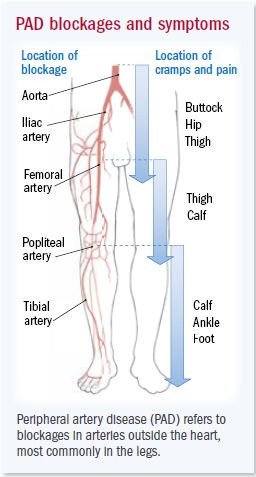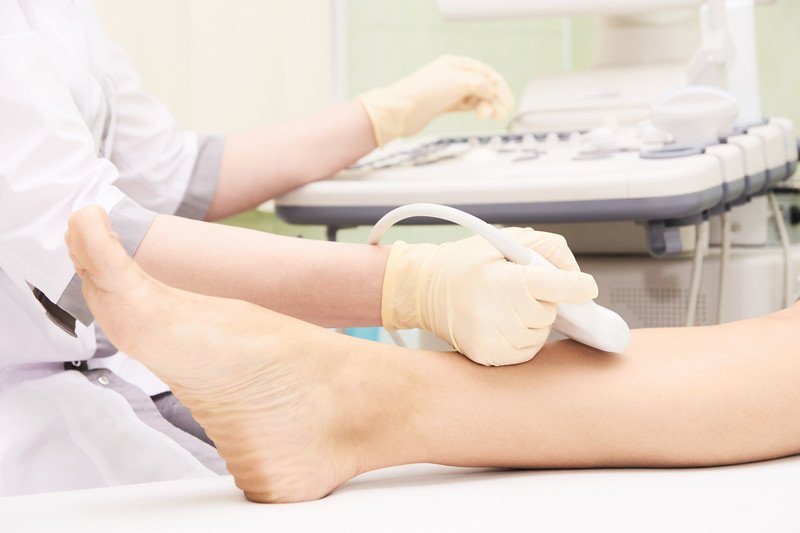Peripheral arterial disease
Medically reviewed by Drugs.com. Last updated on Mar 13, 2025.
What is Peripheral arterial disease?

In peripheral arterial disease (previously called peripheral vascular disease), not enough blood flows to the legs. The condition usually is caused by fatty deposits called plaques that build up along the walls of blood vessels. This buildup shrinks the size of the passageway and reduces the amount of blood that can flow through. This is a condition called atherosclerosis.
|
|
The risk factors for getting peripheral arterial disease are similar to the risk factors for coronary heart disease, and include:
- smoking cigarettes or using other forms of tobacco (such as snuff and chew) An abnormally high level of cholesterol (hypercholesterolemia)
- an abnormally low level of high-density lipoprotein (HDL, the good cholesterol)
- high blood pressure (hypertension)
- diabetes
- family history of cardiovascular disease
- obesity
- physical inactivity (too little regular exercise)
- kidney disease
- race.
Symptoms
The most common symptom of peripheral arterial disease is intermittent claudication – pain or cramping in the legs or buttocks that starts when you exercise and goes away when you rest. Often the pain is described as a deep ache, especially in the calf muscle. The pain may extend to the foot or up toward the thigh and buttock. Sometimes, there is just numbness in the leg or a sense that one leg gets tired when you walk. A foot or toes also may feel cold or numb.
If the arteries are severely narrowed, you could experience leg pain at rest, when you are not exercising. If blood flow stops completely (usually because a blood clot forms in the narrowed vessel), parts of the leg may become pale or turn blue, feel stone cold to the touch and eventually develop gangrene.
Diagnosis
Your doctor will review your personal risk factors for atherosclerosis and your family history. Your doctor will ask if you or any family members have heart disease, high cholesterol, diabetes, kidney disease, high blood pressure or any other circulation disorder. During the physical examination, your doctor will feel the pulse in your upper leg (near the groin), on the inside of your ankle, the top of your foot and the back of your knee. Any weakness in a pulse may be a sign of narrowed arteries.
Usually the doctor can diagnose peripheral arterial disease based on your symptoms, risk factors, the examination of your legs and the strength of your pulses. Your doctor may measure the blood pressure in your legs and compare it to the blood pressure in your arm to calculate the ankle-brachial index, or ABI. The ratio the blood pressure measured at your ankle is compared to the blood pressure measured at your elbow. Normally blood pressure is the same or a little higher in the legs so the ratio is 1.0 or higher.
A ratio of less than 0.95 in either leg indicates narrowing of the arteries in that leg. People who have symptoms of peripheral arterial disease usually have a ratio of 0.8 or less.
Your doctor may order ultrasound of the legs to measure blood flow. The test is non-invasive and painless, using sound waves to create the pictures. If your doctor suspects that you need a procedure to help open a blocked blood vessel, you may need a magnetic resonance imaging (MRI) scan of your arteries or an angiogram, which is an X-ray test that uses dye in the narrowed arteries to reveal the pattern of blood flow and spot blockages.
|
|
Expected duration
Once you have peripheral arterial disease, your arteries usually will remain narrowed. However, even though your arteries are narrowed, your symptoms can decrease and even go away with treatment.
Prevention
You can help to prevent peripheral arterial disease by modifying your risk factors:
- Don't smoke. This a major risk factor that you can control.
- Maintain a healthy weight. Obesity, especially a concentration of body fat around the waist, has been linked to unhealthy blood levels of cholesterol and other fats, which can build up inside your arteries.
- Eat a healthy diet. Your diet should be loaded with vegetables and fruits, and it should be low in saturated fats.
- Exercise regularly. Ideally, you should exercise 45 minutes or more every day.
- Lower your blood pressure. Medications may be necessary if maintaining a healthy lifestyle is not enough.
Drugs used to treat this and similar conditions
Treatment
Treatment for peripheral arterial disease includes:
- Modifying risk factors. Quitting smoking can reduce the symptoms of intermittent claudication and decrease the likelihood that the disease will get worse. It is also important to lower your cholesterol levels if they are high, keep blood pressure in the normal range, and keep your diabetes well-controlled. Talk to your doctor about the best way to do this.
- Exercise programs. Studies have shown that people who exercise can nearly double the distance they can walk before they start feeling leg pain. Try to exercise at least 30 minutes every day. You may need frequent breaks if your legs hurt. Even if you have to stop every few minutes, don't give up. Any activity is very beneficial. Most people choose walking, and find that walking on a track or a treadmill is easier than walking on pavement. You could also try bike riding (stationary or standard) and swimming.
- Medications. Even if you exercise and modify your risk factors, medications can help you to better relieve symptoms and may help to slow the progression of the disease. A medication called cilostazol (Pletal) helps increase blood flow to muscles and thereby decrease the symptoms of intermittent claudication. People with peripheral arterial disease almost always have blockages in other arteries, including those that supply blood to the heart and brain. So, it's important to reduce the risk of heart attack and stroke, which usually means taking aspirin and a statin drug.
- Revascularization procedures. The goal of revascularization is to improve circulation, either by opening narrowed arteries or by bypassing the narrowed section of the artery. These procedures include surgical and non-surgical techniques and are used in people who have severe or progressive symptoms, or whose leg pain occurs at rest. The most common non-surgical procedure is percutaneous transluminal angioplasty, also called balloon angioplasty. In this procedure, a catheter is inserted into the narrowed artery and a small balloon at the tip is inflated to open the narrowed vessel. Often, a metallic implant called a stent is used as a scaffold to support the wall of the artery after it is opened with the balloon. In some people, the narrowed vessel must be bypassed surgically using either a section of vein taken from the leg or a synthetic graft.
Treatment options
The following list of medications are related to or used in the treatment of this condition.
When to call a professional
Call your doctor if you consistently suffer from cramps, aching, numbness or disproportionate fatigue in your leg muscles or buttocks when you exercise. Call immediately if you have these symptoms at rest or when any part of your leg or foot suddenly turns numb, cold, pale or a bluish color.
Prognosis
In most people with peripheral arterial disease, leg symptoms remain stable. About 10% to 15% of patients improve, and about 15% to 20% get worse. The outlook is better for people who are able to remain tobacco-free, stay on a healthy diet, keep their blood cholesterol under control and exercise regularly.
Additional info
National Heart, Lung and Blood Institute (NHLBI)
https://www.nhlbi.nih.gov/
Learn more about Peripheral arterial disease
Treatment options
Care guides
Medicine.com guides (external)
Further information
Always consult your healthcare provider to ensure the information displayed on this page applies to your personal circumstances.


